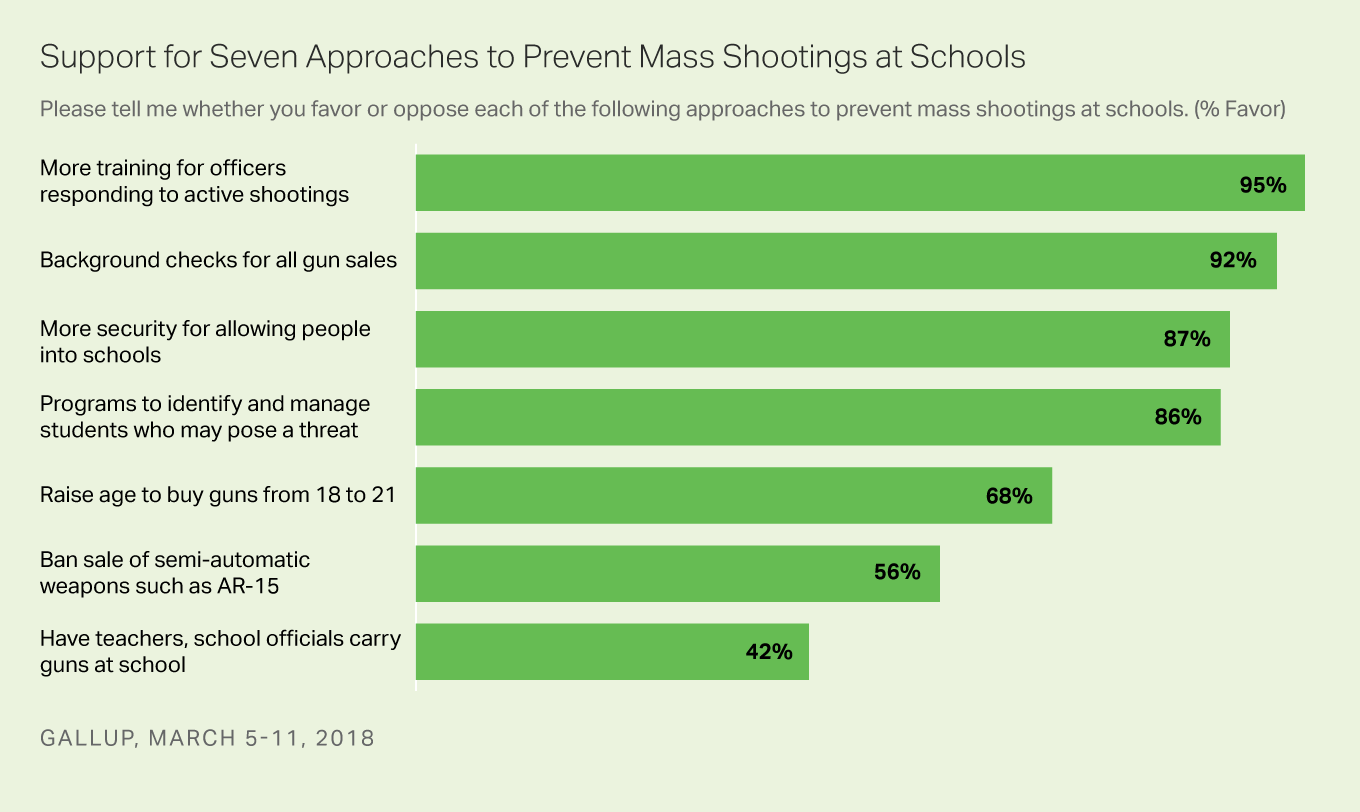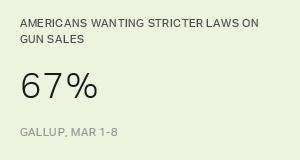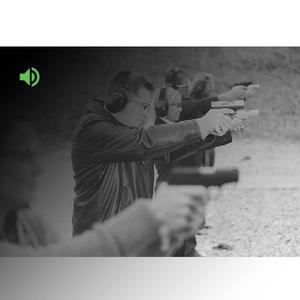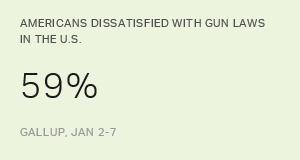Story Highlights
- More than nine in 10 favor background checks, better school security training
- 42% favor, 56% oppose arming teachers
- Most proposals are viewed as potentially at least somewhat effective
WASHINGTON, D.C. -- Americans strongly favor a number of proposals for reducing mass shootings at schools, including increasing training for police officers and those who respond to active shooters, background checks for all gun sales, higher levels of security at schools, and new programs to identify and manage students who may pose a threat. These proposals are essentially noncontroversial given their enormously high public approval.
Two other actions -- raising the legal age for purchasing certain firearms from 18 to 21 and banning the sale of semi-automatic weapons such as the AR-15 -- receive lower levels of support, although still well above a simple majority.
The only approach among those tested in Gallup's March 5-11 update that less than half of Americans favor is "having teachers or other school officials with appropriate training carry guns at school," although the 42% who back it is still substantial.

The probability that any of these gun control proposals will become law at either the state or federal level may depend on the extent to which each earns bipartisan support. The four actions that have the public's overwhelming support do so because vast majorities of Republicans and Democrats support them. This broad bipartisan agreement helps explain why a bill including three of the proposals (but not background checks) sailed through a U.S. House vote in Washington on Wednesday with almost universal support from both sides of the aisle.
Democrats and Republicans have quite different opinions when it comes to the other three proposals, suggesting these would face more difficulty in winning legislative approval.
- For two of these measures -- banning semi-automatic weapons and raising the age limit to buy guns -- support among Republicans, including Republican-leaning independents, is significantly lower than among Democrats and Democratic leaners.
- The proposal to arm teachers and other school officials generates the mirror-opposite reactions, with Republicans over three times as likely as Democrats to favor the idea.
| Democrats/Leaners | Republicans/Leaners | |||||||||||||||||||||||||||||||||||||||||||||||||||||||||||||||||||||||||||||||||||||||||||||||||||
|---|---|---|---|---|---|---|---|---|---|---|---|---|---|---|---|---|---|---|---|---|---|---|---|---|---|---|---|---|---|---|---|---|---|---|---|---|---|---|---|---|---|---|---|---|---|---|---|---|---|---|---|---|---|---|---|---|---|---|---|---|---|---|---|---|---|---|---|---|---|---|---|---|---|---|---|---|---|---|---|---|---|---|---|---|---|---|---|---|---|---|---|---|---|---|---|---|---|---|---|---|
| % Favoring | % Favoring | |||||||||||||||||||||||||||||||||||||||||||||||||||||||||||||||||||||||||||||||||||||||||||||||||||
| Broad agreement | ||||||||||||||||||||||||||||||||||||||||||||||||||||||||||||||||||||||||||||||||||||||||||||||||||||
| Increased training for police officers and first responders on how to respond to active shootings | 96 | 94 | ||||||||||||||||||||||||||||||||||||||||||||||||||||||||||||||||||||||||||||||||||||||||||||||||||
| Requiring background checks for all gun sales | 96 | 86 | ||||||||||||||||||||||||||||||||||||||||||||||||||||||||||||||||||||||||||||||||||||||||||||||||||
| Installing more security checkpoints and security systems for allowing people into schools | 83 | 91 | ||||||||||||||||||||||||||||||||||||||||||||||||||||||||||||||||||||||||||||||||||||||||||||||||||
| Instituting new programs to identify, assess and manage certain students who may pose a threat | 87 | 85 | ||||||||||||||||||||||||||||||||||||||||||||||||||||||||||||||||||||||||||||||||||||||||||||||||||
| Democrats significantly more likely to be in favor | ||||||||||||||||||||||||||||||||||||||||||||||||||||||||||||||||||||||||||||||||||||||||||||||||||||
| Raising the legal age at which people can purchase certain firearms from 18 to 21 | 83 | 53 | ||||||||||||||||||||||||||||||||||||||||||||||||||||||||||||||||||||||||||||||||||||||||||||||||||
| Banning the sale of semi-automatic weapons such as the AR-15 | 72 | 37 | ||||||||||||||||||||||||||||||||||||||||||||||||||||||||||||||||||||||||||||||||||||||||||||||||||
| Republicans significantly more likely to be in favor | ||||||||||||||||||||||||||||||||||||||||||||||||||||||||||||||||||||||||||||||||||||||||||||||||||||
| Having teachers or other school officials with appropriate training carry guns at school | 22 | 69 | ||||||||||||||||||||||||||||||||||||||||||||||||||||||||||||||||||||||||||||||||||||||||||||||||||
| GALLUP, March 5-11, 2018 | ||||||||||||||||||||||||||||||||||||||||||||||||||||||||||||||||||||||||||||||||||||||||||||||||||||
Background Checks Seen as Most Effective
Not only do clear majorities of Americans favor six of the seven approaches to reducing school shootings tested, but significant majorities believe each of the six would be very or somewhat effective if implemented. Only the proposal to arm schoolteachers gets less than a 50% effectiveness rating, with slightly over half saying it would be not too or not at all effective.
The view that each proposal would be very effective in preventing school shootings, however, varies across all seven proposals. Seven in 10 Americans say requiring background checks for all gun sales would be very effective, topping the list. The other three proposals that get broad support from Americans also have majority perceived "very effective" ratings, including increased police training, more security, and programs to identify and deal with students who may pose a threat.
The three proposals that split Americans along political lines -- raising the age limit to purchase guns, banning semi-automatic weapons and arming teachers -- are ones that less than half of Americans believe would be very effective, with a third or more saying they would be not too or not at all effective.
The controversial proposal to arm teachers or other school officials stands out at the bottom of the list, with just 27% saying it would be very effective in preventing mass school shootings, and 53% -- by far the highest of any proposal -- saying it would be not too (14%) or not at all (39%) effective.
| Very effective | Somewhat effective | Not too/Not at all effective | |||||||||||||||||||||||||||||||||||||||||||||||||||||||||||||||||||||||||||||||||||||||||||||||||
|---|---|---|---|---|---|---|---|---|---|---|---|---|---|---|---|---|---|---|---|---|---|---|---|---|---|---|---|---|---|---|---|---|---|---|---|---|---|---|---|---|---|---|---|---|---|---|---|---|---|---|---|---|---|---|---|---|---|---|---|---|---|---|---|---|---|---|---|---|---|---|---|---|---|---|---|---|---|---|---|---|---|---|---|---|---|---|---|---|---|---|---|---|---|---|---|---|---|---|---|
| % | % | % | |||||||||||||||||||||||||||||||||||||||||||||||||||||||||||||||||||||||||||||||||||||||||||||||||
| Requiring background checks for all gun sales | 70 | 19 | 10 | ||||||||||||||||||||||||||||||||||||||||||||||||||||||||||||||||||||||||||||||||||||||||||||||||
| Increased training for police officers and first responders on how to respond to active shootings | 60 | 30 | 10 | ||||||||||||||||||||||||||||||||||||||||||||||||||||||||||||||||||||||||||||||||||||||||||||||||
| Installing more security checkpoints and security systems for allowing people into schools | 54 | 32 | 13 | ||||||||||||||||||||||||||||||||||||||||||||||||||||||||||||||||||||||||||||||||||||||||||||||||
| Instituting new programs to identify, assess and manage certain students who may pose a threat | 52 | 32 | 14 | ||||||||||||||||||||||||||||||||||||||||||||||||||||||||||||||||||||||||||||||||||||||||||||||||
| Banning the sale of semi-automatic weapons such as the AR-15 | 48 | 15 | 35 | ||||||||||||||||||||||||||||||||||||||||||||||||||||||||||||||||||||||||||||||||||||||||||||||||
| Raising the legal age at which people can purchase certain firearms from 18 to 21 | 40 | 26 | 33 | ||||||||||||||||||||||||||||||||||||||||||||||||||||||||||||||||||||||||||||||||||||||||||||||||
| Having teachers or other school officials with appropriate training carry guns at school | 27 | 20 | 53 | ||||||||||||||||||||||||||||||||||||||||||||||||||||||||||||||||||||||||||||||||||||||||||||||||
| Sorted by "very/somewhat effective" | |||||||||||||||||||||||||||||||||||||||||||||||||||||||||||||||||||||||||||||||||||||||||||||||||||
| GALLUP, March 5-11, 2018 | |||||||||||||||||||||||||||||||||||||||||||||||||||||||||||||||||||||||||||||||||||||||||||||||||||
Bottom Line
Americans strongly favor increasing measures focused on school safety -- including figuring out how to isolate students who might constitute threats, and background checks for all gun sales -- and believe each would be effective in preventing school shootings. Elected representatives at the state and federal levels can feel confident in endorsing such measures, at least from a broad public opinion perspective.
The U.S. House, as an example, approved a school safety bill on Wednesday that included training school officials and first responders, increasing school security and providing money to develop programs to deal with possible threats. Majorities of both Republican and Democratic House members voted for these noncontroversial measures, all of which the public overwhelmingly approves of -- although House Democrats complained the bill did not go nearly far enough.
A potentially greater legislative battle may occur for the more controversial measures on which Republicans and Democrats strongly disagree. These include the idea of arming teachers and school officials -- endorsed by Republicans but overwhelmingly opposed by Democrats -- and raising the gun purchase age and banning the sale of semi-automatic weapons, favored by Democrats but opposed by Republicans.
But recent actions in Florida, where the Parkland shootings took place a month ago, show that the partisan divides on what to do to prevent school shootings can be bridged. The Republican-controlled legislature in the Sunshine State recently passed a new law -- signed by Republican Gov. Rick Scott -- which included the noncontroversial measures dealing with school security and mental health, but also raised the age limit for firearm purchases to 21. Additionally, the law allowed arming teachers in local areas where the school district and the local sheriff approve.
The school walkout protests across the country on Wednesday underscored the building momentum for elected representatives at the federal and state levels to continue to act and to pass laws on helping prevent school shootings.
Survey Methods
Results for this Gallup poll are based on telephone interviews conducted March 5-11, 2018, on the Gallup U.S. Poll, with a random sample of 1,515 adults, aged 18 and older, living in all 50 U.S. states and the District of Columbia. For results based on the total sample of national adults, the margin of sampling error is ±3 percentage points at the 95% confidence level. The favor/oppose list question was asked of a random subsample of 767 adults, and the effectiveness list question was asked of a random subsample of 748 adults. For these results, the margin of sampling error is ±5 percentage points at the 95% confidence level. All reported margins of sampling error include computed design effects for weighting.
Each sample of national adults includes a minimum quota of 70% cellphone respondents and 30% landline respondents, with additional minimum quotas by time zone within region. Landline and cellular telephone numbers are selected using random-digit-dial methods.
View survey methodology, complete question responses and trends.
Learn more about how the Gallup U.S. Poll works.





